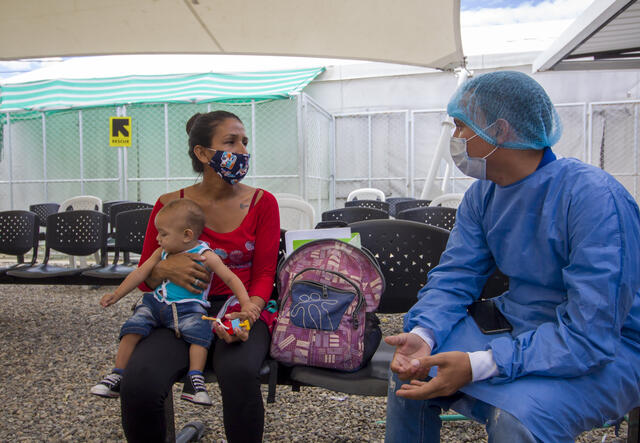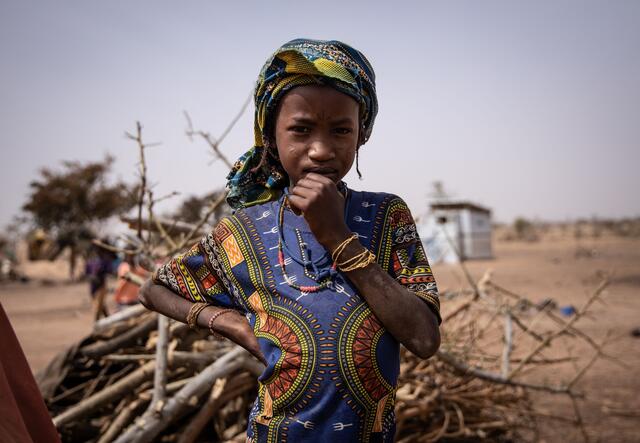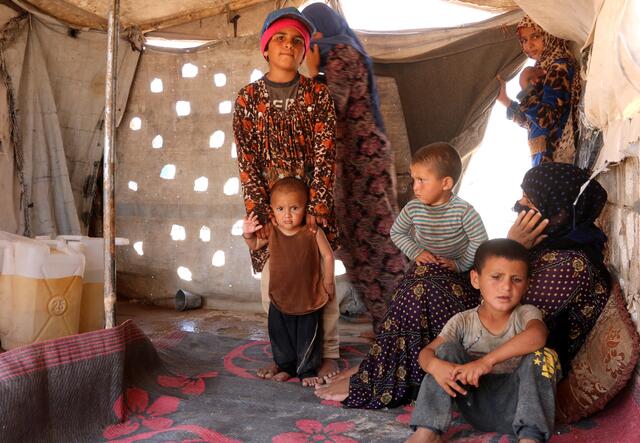
The top 10 crises the world should be watching in 2021
The 2021 Emergency Watchlist reveals the world is facing unprecedented humanitarian emergencies—as well as a political crisis of inaction by world leaders. Learn more and find out how to help.

The 2021 Emergency Watchlist reveals the world is facing unprecedented humanitarian emergencies—as well as a political crisis of inaction by world leaders. Learn more and find out how to help.
Update—July 19, 2022: With a catastrophic famine looming on the horizon across East Africa, the International Rescue Committee (IRC) has released our first ever Crisis Alert update to our annual Emergency Watchlist, highlighting that over 3 million people could die without urgent international funding. Learn more about the famine threat.
The International Rescue Committee has released its 2021 Emergency Watchlist, a global list of humanitarian crises that are expected to deteriorate the most over the coming year. The triple threat of conflict, climate change and COVID-19 is driving the crises in nearly all Emergency Watchlist countries, threatening famine in several in 2021.
Displaced families, and in particular women and girls, are disproportionately affected by humanitarian crises—and the COVID-19 pandemic is no exception.
“2020 will go down as one of the most turbulent years in history, but the next year will be remembered for how we either helped or turned away from those suffering the most,” says IRC president and CEO David Miliband. “Watchlist 2021 should serve as a wake-up call for policymakers, government leaders, and concerned citizens around the world about the cost of neglecting humanitarian crises—and how they urgently need international attention.”
Learn more about the world's worst crises:
Population: 31.3 million
People in need of aid: 1.3 million
2020 Emergency Watchlist position: Unlisted
The number of people in need in Mozambique has nearly doubled as an insurgency grips a country still struggling to recover from two powerful cyclones that struck in 2019. The rapidly escalating conflict in the northern Cabo Delgado province has pushed Mozambique not just onto the Emergency Watchlist for the first time, but straight into the list’s top ten countries of most concern.
Humanitarian risks in Mozambique in 2021
Population: 28.7 million
People in need of aid: 7 million
2020 Emergency Watchlist position: 5
The collapse of Venezuela’s oil industry has been a key factor in a deepening economic crisis that has devastated the country’s health system and caused widespread hunger and displacement. COVID-19 restrictions have left Venezuelans stuck in limbo, unable to leave the country to seek safety and services—while lockdowns elsewhere are forcing those who had already left Venezuela to return.

Humanitarian risks in Venezuela in 2021
The IRC's crisis response in Venezuela
Launched: 2018. Where we focus with local partners: Maternal health care; sexual and reproductive health care; provision of masks and other COVID-19 protective gear; child malnutrition services; child protection services; gender-based violence prevention and response; cash assistance.
Learn more about the IRC’s Venezuela response and our support for Venezuelans in neighboring Colombia.
Population: 206.1 million
People in need of aid: 8.9 million
2020 Emergency Watchlist position: 4
Even after a decade of conflict that has uprooted nearly 3 million people and left millions more facing a hunger crisis, violence is still growing in northeast Nigeria. Civilians are bearing the brunt of the conflict; Nigeria was the deadliest crisis for civilians in 2020 out of all 20 Emergency Watchlist countries. It remains a challenging place for aid workers to provide humanitarian assistance.
Humanitarian risks in Nigeria in 2021
The IRC's crisis response in Nigeria
Launched: 2012. Where we focus: Primary health, nutrition and reproductive health care; educational support services for out-of-school youth, women’s protection and empowerment; water and sanitation services; economic recovery and development.
Learn more about the IRC's work in Nigeria.
Population: 11.2 million
People in need of aid: 7.5 million
2020 Emergency Watchlist position: 7
South Sudan’s high Emergency Watchlist ranking is driven by widespread humanitarian needs and a fragile peace deal that could unravel under the additional strain of COVID-19. A new unity government took office in early 2020. It faces the challenge of leading the country’s recovery from civil conflict amid unrelenting violence, an economic crisis, and now an unprecedented pandemic in one of the world’s weakest health systems.
Humanitarian risks in South Sudan in 2021
The IRC's crisis response in South Sudan
Launched: 1989. Where we focus: capacity building in state health clinics; training local health workers; nutrition programs; sanitation services; support to survivors of sexual violence; child protection services; human rights training; cash assistance; job and livelihoods training.
Learn more about the IRC’s South Sudan response.
Population: 20.9 million
People in need of aid: 3.5 million
2020 Emergency Watchlist position: 8
Just two years ago, Burkina Faso faced virtually no mass conflict or displacement. It entered the Emergency Watchlist for the first time last year and is now ranked at six. The escalating conflict is driving steep increases in humanitarian need and—with the economic impact of the COVID-19 crisis—the risk of famine. Over 1 million people are now internally displaced in Burkina Faso, more than double the number at the start of 2020.

Humanitarian risks in Burkina Faso in 2021
The IRC's crisis response in Burkina Faso
Launched: 2019. Where we focus: clean water; sanitation service support; primary health care, including reproductive health care and child health care.
Learn more about the IRC’s Burkina Faso response.
Population: 115 million
People in need of aid: 21.3 million
2020 Emergency Watchlist position: Listed, unranked
On the Emergency Watchlist for the third year running, Ethiopia enters 2021 with a major confrontation underway in the northern Tigray region between the federal government and the Tigray People’s Liberation Front (TPLF). At the same time, climate change, the biggest locust outbreak in living memory, and the COVID-19 pandemic all drive up the number of people in need to the second highest in the world.

Humanitarian risks in Ethiopia in 2021
The IRC's crisis response in Ethiopia
Launched: 2000. Where we focus: cash and basic emergency supplies; safe water and sanitation facilities; women and girls’ protection; primary health care; education; livelihoods-related training and job opportunities for youth and vulnerable households.
Learn more about the IRC’s Ethiopia response.
Population: 89.6 million
People in need of aid: 19.6 million
2020 Emergency Watchlist position: 2
There are now more people facing a severe hunger crisis in the Democratic Republic Congo than has ever been recorded in any country. Congo ranks in the emergency Watchlist top five for the third year in a row, reflecting persistent volatility in a country that is now in its fourth decade of a major humanitarian crisis. On top of large-scale violence, Congo also has had to grapple with outbreaks of Ebola and COVID-19.
Humanitarian risks in Congo in 2021
The IRC's crisis response in Congo
Launched: 1996. Where we focus: Health care: containing Ebola and COVID-19 outbreaks, health worker training, rehabilitation of hospitals and clinics, water, sanitation; support for survivors of violence; conflict reduction; economic recovery.
Learn more about the IRC's response in Congo.
Population: 17.5 million
People in need of aid: 13 million
2020 Emergency Watchlist position: 3
The year 2021 marks a decade of conflict in Syria, as violence, displacement and humanitarian needs continue to grow. Syria is also the deadliest country in the world for humanitarians. Attacks on aid workers, civilians, homes and hospitals remain common. Many families have been uprooted multiple times. The health system has been decimated, undermining Syrians’ ability to cope with the challenges of COVID-19.

Humanitarian risks in Syria in 2021
The IRC's crisis response in Syria
Launched: 2012. Where we focus: support for health facilities and mobile health teams with trauma, primary, reproductive, and mental health services; COVID-19 awareness, and infection, prevention, and control training; food and cash distributions; women and children’s protection; early childhood development programs.
Learn more about the IRC’s Syria response.
Population: 38.9 million
People in need of aid: 18.4 million
2020 Emergency Watchlist position: 6
Afghanistan has risen to second on the Emergency Watchlist because of its high exposure to the triple threats of conflict, COVID-19 and climate change, as well as uncertainty over the stalled peace process between the government and the Taliban. Even after four decades of crises, humanitarian needs in Afghanistan are growing rapidly amid the pandemic and unrelenting violence, with the number of people requiring aid for 2021 nearly doubling compared to early 2020.
Humanitarian risks in Afghanistan in 2021
The IRC's crisis response in Afghanistan
Launched: 1988. Where we focus: education; child protection; water and sanitation, including hand-washing station installation; support for health facilities; COVID-19 prevention information and training sessions; emergency response; economic recovery; women’s protection and empowerment.
Learn more about the IRC’s Afghanistan response.
Population: 29.8 million
People in need of aid: 24.3 million
2020 Emergency Watchlist position: 1
Yemen tops the IRC's annual Emergency Watchlist for the third year running. Over five years of major armed conflict, severe underfunding, and now the COVID-19 crisis have pushed the humanitarian response to the brink of collapse in 2020. Eighty percent of the population is in need of aid. Yemenis tell the IRC they worry more about hunger than COVID-19: As the pandemic deepens the country’s economic crisis, and with no political resolution in sight, Yemen faces the risk of famine.

Humanitarian risks in Yemen in 2021
Read more about why Yemen is the country most at risk of humanitarian catastrophe in 2021.
The IRC's crisis response in Yemen
Launched: 2012. Where we focus: primary health facilities; emergency obstetric and newborn care centers; reproductive health care; mobile health teams; a COVID-19 isolation unit; treatment for malnourished children; cash transfers; livelihood programs; women and children’s protection; water and sanitation services; education.
Learn more about the IRC's Yemen response.
The world is facing unprecedented humanitarian emergencies in the coming year. The worst humanitarian crises of 2021 will be in countries failed by world leaders. The global response to the COVID-19 pandemic has left countries affected by conflict and crisis to struggle on their own—and the world’s most vulnerable people are paying the price. The effects of climate change will only exacerbate these crises. The international community must take action now, before decades of hard-won progress on reducing poverty, hunger and disease is lost or even reversed.
Top 3 crises we’re most concerned about in 2021 from our annual emergency watchlist:
— IRC - International Rescue Committee (@RESCUEorg) December 16, 2020
▪️Yemen
▪️Afghanistan
▪️Syria
Here is why we’re most concerned about these 3 countries and how you can help.
RT to help us raise awareness and critical action. More: https://t.co/YyagR43BzMpic.twitter.com/R8U36TpGEb
The Emergency Watchlist draws on 85 quantitative and qualitative measures, including insights from the IRC’s 30,000 staff and volunteers in over 40 countries globally. For IRC analysis of all 20 countries in our world crisis 2021 list, along with our recommendations for global leaders, download the 2021 Emergency Watchlist report.
You can also test your knowledge of the world's worst crises with our quiz.
In 2021, the IRC will have been working for an average of around 15 years in the 18 Emergency Watchlist countries where we have a presence.
The IRC responds to the world’s worst humanitarian crises and helps people whose lives and livelihoods are shattered by conflict and disaster to survive, recover and gain control of their future. In more than 40 countries and over 20 U.S. cities, our dedicated teams provide clean water, shelter, health care, education and empowerment support to refugees and displaced people.
The IRC released our 2022 Emergency Watchlist on December 15, 2021:Read profiles of the top 10 crises the world can't ignore in 2022.